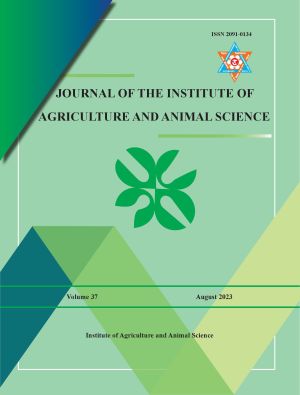In-vitro Compatibility Assessment of Trichoderma harzianum with Chemical Fungicides and Botanical Extracts
DOI:
https://doi.org/10.3126/jiaas.v37i1.56993Keywords:
Biocontrol, integrated disease management, poisoned food techniqueAbstract
The threats of devastating soil-borne disease, limited availability of its management strategies, development of fungicide-resistant strains, outbreaks of new diseases, and growing concerns regarding nature and the environment have compelled us to use integrated disease management (IDM) strategies with appropriate biocontrol agents. Trichoderma, free-living fungi, are successful antagonists with promising biocontrol potentials and can be used with chemicals and botanicals in the IDM approach to control various plant pathogenic fungi. So, the present experiment was conducted to evaluate the compatibility of Trichoderma harzianum with chemical fungicides and botanicals in in-vitro using a poisoned food technique. The experiment was conducted in a completely randomized design with three replications for each treatment at the central laboratory of the Institute of Agriculture and Animal Science, Lamjung, Nepal, and data were taken at different time intervals and analyzed. For fungicides, the maximum compatibility was found in Copper oxychloride at 100 ppm, and the highest inhibition (100%) was observed in Carbendazim + Mancozeb, Carbendazim, and Hexaconazole even in lower concentration (100 ppm). For botanicals, Azadirachta indica and Zingiber officinale enhanced T. harzianum, and the highest compatibility was observed at 10% leaves extract of Azadirachta indica with a growth inhibition percentage of -5.43% (Day 5). Aqueous extracts of tested botanicals were found compatible with T. harzianum, except for the Acorus calamus, Artemisia vulgaris, and Allium sativum. In IDM practice, compatible fungicides and botanicals at recommended doses can be used with T. harzianum.
Downloads
Downloads
Published
How to Cite
Issue
Section
License
Copyright (c) 2023 Tribhuvan University Institute of Agriculture and Animal Science

This work is licensed under a Creative Commons Attribution-NonCommercial 4.0 International License.

